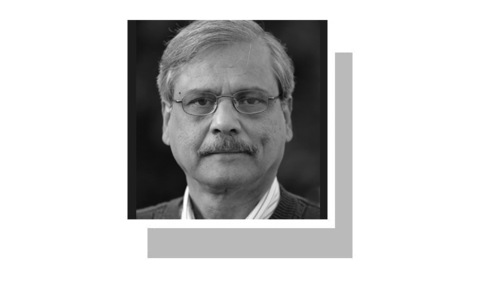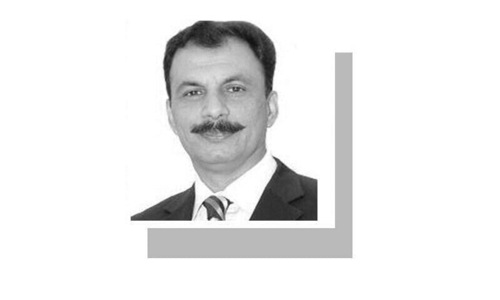• Economic Survey to be formally unveiled today, budget scheduled for tomorrow
• Govt concedes import controls, political uncertainty caused economic downfall in outgoing fiscal year
• Blames previous regime for leaving economy ‘marred with imbalances’
ISLAMABAD: The government has conceded that lingering political instability, import controls and tight monetary policies caused the country’s prevailing economic downfall, taking the blame for the turmoil it has largely pinned on the usual suspects: the PTI and the floods.
However, the coalition government expects that political stability would help put the country towards economic recovery and growth path.
This is one of the key themes of the economic review of the current fiscal year to be rolled out on Thursday (today) as part of the Pakistan Economic Survey 2022-23 by the coalition governments’ economic team led by Finance Minister Ishaq Dar. It will be followed by the budget announcement on Friday.
The broad overview of the macroeconomic performance was shared with the National Economic Council (NEC) on Wednesday, along with targets for the next fiscal year. The government is forecasting the economic outlook for the next year as positive, with a growth target of 3.5pc.
“The revival of growth hinges upon political stability, external account, and macroeconomic stability amid expected fall in global oil and commodity prices,” the document says. “With falling global inflation, domestic inflation is expected to gradually reduce next year but will remain in double digits.”
All three major sectors of the economy — agriculture, industry and services — saw broad-based failures as the gross domestic product (GDP) grew by just 0.3pc against the target of 5pc during the current fiscal year.
The government has blamed the previous government and accused it of leaving behind an economy “marred with huge macroeconomic imbalances including highest ever public debt, dwindling foreign exchange reserves, about 11pc currency depreciation, a massive circular debt and high fiscal and current account deficits”, fuelled by highest ever import burden of $84.5bn.
But then it concedes that “lingering political instability, delay in the resumption of the IMF programme and bleak prospects of global growth shattered investors’ confidence”.
The State Bank of Pakistan, it says, had to adopt a tight monetary policy throughout the year due to high inflation and this impeded economic activity.
Because of the inherited external sector vulnerabilities, “the present government was compelled to take a hard decision of import compression to prevent the haemorrhage of dwindling foreign exchange reserves. Consequently, the current account deficit (CAD) fell 76pc and provided much-needed space to avert sovereign default”.
It argues that the economic fundamentals that pushed the economic growth in 2021-22 were not sustainable and thus the real GDP was projected to shave off some growth momentum.
The government advocates that agriculture was badly affected by floods and the “industrial sector faced double jeopardy as breaks in the supply chain of raw materials caused by floods were complemented by import restrictions”.
The service sector was adversely affected by the outcome in the commodity-producing sectors. Against this backdrop, the economy grew by just 0.3pc against the 5pc target due to lower-than-projected growth of 1.5pc in the agriculture sector against the 3.9pc target; 0.9pc growth in the service sector against the targeted 5.1pc; and a contraction of 2.9pc in the industrial sector against the 5.9pc growth target.
It said flood-induced supply shock severely affected industry and service sectors besides damaging critical transport infrastructure like roads and railway tracks.
The industrial sector also faced pressures as import restrictions made it difficult to import essential raw materials, intermediate goods and machinery.
“Resultantly, many factories either closed temporarily or operated below capacity. Moreover, increase in energy prices, higher cost of imported input due to currency depreciation, increased cost of working capital due to substantial increase in interest rates and political uncertainty adversely affected the industrial sector,” the official document concedes.
It said large-scale manufacturing shrank 8pc this year compared to a 10.6pc growth last year. The mining and quarrying sub-sector also contracted 4.4pc against the target of 3pc due to a decline in natural gas, crude oil, other minerals and exploration services.
Besides, the construction sector contracted 5.5pc, apparently due to less spending by public enterprises and an increase in the prices of construction materials.
So, the fall in mining, large-scale manufacturing and construction led to a contraction of 2.9pc in the industrial sector.
The investment-to-GDP ratio dropped from 15.7pc in 2021-22 to 13.6pc in 2022-23, with a decrease in both public and private investment-to-GDP ratios. Investment grew by 10.2pc in nominal terms, but it decreased by 15.4pc in real terms due to high inflation.
Moreover, credit off-take by private businesses decreased to Rs158 billion during July-April as against Rs.1.1tr a year ago. The credit for working capital decreased to Rs170bn from Rs576bn, whereas credit for fixed investment fell to Rs182bn from Rs350bn in the year-ago period.
In the first nine months (July to March) of the current fiscal year, the fiscal deficit stood at 3.6pc of GDP compared to 3.9pc a year ago. Total revenue grew 18.1pc, but the tax-to-GDP ratio decreased from 7.2pc to 6.6pc.
Total expenditure grew by 18.7pc during July-March, mainly due to 25.3pc growth in current expenditure. The fiscal deficit primarily originated from the growth of current expenditure with a major share of markup payments (54.2pc) in federal current expenditure and its growth of 69.1pc.
The stock of gross public debt increased 20.3pc to Rs59.2tr (88.9pc of GDP) by the end of March from Rs49.2 trillion (73.9pc of GDP) by the end of June last year.
Domestic debt grew by 12.8pc from Rs31.1tr to Rs35.1tr, while external debt increased by 33.1pc from Rs18.2tr to Rs24.2tr from July to March.
During July-April, the SBP increased the policy rate from 13.75pc to 21pc to tame inflation and achieve price stability.
Average inflation came at 28.2pc in July-April compared to 11pc a year ago. It was mainly contributed by food inflation which remained higher at 37.6pc compared to 11.7pc last year, whereas non-food inflation rose to 21.4pc compared to 10.6pc a year ago.
Domestic energy prices (gas, electricity, and fuel) were increased by reversing unsustainable fuel and electricity subsidies as part of a stabilisation programme, which also stoked up inflation, both directly and indirectly.
Higher transport costs also fuelled inflation as petrol prices rose after the petroleum levy was reintroduced.
Imports during the 10 months through April stood at $45.2bn, down 23pc from $58.5bn a year ago, primarily because of the government’s restrictions on opening letters of credit, uncertainty surrounding foreign exchange availability and political instability.
Published in Dawn, June 8th, 2023















































Dear visitor, the comments section is undergoing an overhaul and will return soon.